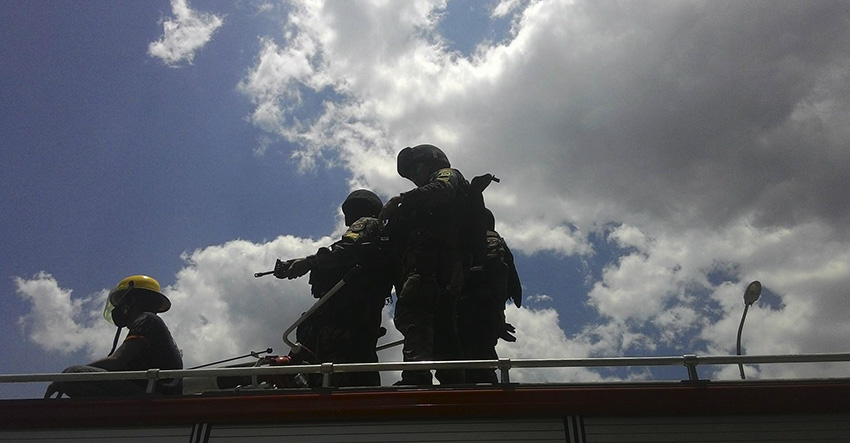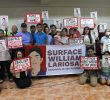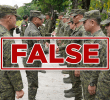
SECURITY FORCES. During the first day of the farmers’ barricade in Kidapawan City on Wednesday, March 31, members of the SWAT team are positioned atop fire trucks. (Contributed photo by Kath Cortez)
Apparent excessive force used at Kidapawan protest
KIDAPAWAN CITY, the Philippines – The Philippine police may have used unnecessary lethal force in breaking up a demonstration by farmers in Kidapawan City on April 1, 2016, Human Rights Watch said today. The police used batons and guns against the protesters, including women and children, some of whom threw rocks at the police.
Darwin Sulang, 22, and a bystander, Enrico Fabligar, 30, were fatally shot, and dozens who were injured required hospitalization for gunshot and other wounds. The police also reported injuries to their officers. Police have detained 79 protesters and charged 74 of them with offenses including assaulting a police officer. Three separate investigations into the incident are underway by the official Commission on Human Rights, the Philippines National Police, and the Senate Committee on Justice and Human Rights.
“The Philippine government needs to determine why the police found it necessary to fire at protesters,” said Phelim Kine, deputy Asia director at Human Rights Watch. “Some protesters were throwing stones, but lethal force may only be used as a last resort to save lives.”
Human Rights Watch interviewed eyewitnesses to the protests, and called for the government to ensure that investigations into police use of force are credible, transparent, and impartial.
Some 6,000 protesters, primarily farmers and supporters from drought-stricken areas in North Cotabato and Bukidnon provinces on the southern island of Mindanao, gathered in Kidapawan City beginning March 28, calling for government food aid and other assistance. On March 30, the group protested by blocking the main highway into the city. On April 1, Philippine National Police personnel, some with riot shields and helmets, led an operation to clear the protesters from the road, backed by a Special Weapons and Tactics (SWAT) unit equipped with military-style body armor and M-16 assault rifles.
Witnesses told Human Rights Watch that the police began donning their crowd-control gear at about 9 a.m. on April 1. Minutes after the crowd was ordered to disperse, a phalanx of police officers and SWAT unit personnel used batons to push through the crowd. When protesters responded by throwing rocks, fire trucks used water cannons against the stone-throwers. A video shows protesters advancing toward the police followed by apparently uncoordinated gunfire that continues sporadically.
Since the incident, local and national government officials have alleged that groups linked to the insurgent communist New People’s Army organized the protest. Protesters have denied any such links.
The mayor of Kidapawan City, Joseph Evangelista, told Human Rights Watch that he tried to negotiate a peaceful resolution of the protest with the assistance of the local Catholic diocese beginning March 30, but said that protest organizers refused to meet. He described the police decision to fire into the crowd as “warning shots” intended to protect two policemen allegedly “about to be killed” by protesters.
The North Cotabato police chief, Alex Tagum, said that police fired on protesters “to defend the people who are helpless and about to be killed,” but provided no details. Police Superintendent Jerson Berrey, who supervised the police operation, said police had “reliable reports that there were armed elements that [were] maybe accompanying the [protesters].” He said that this concern, along with Kidapawan City’s history of being “very prone to terror attacks and bus burnings and kidnappings,” prompted him to order the deployment of a SWAT unit to help deter potential “terror attacks and [situations in which] the police will be made sitting ducks.” Human Rights Watch has been unable to confirm Berrey’s assertion of possible “armed elements” among the protesters.
The nongovernmental Health Alliance for Human Rights reported at a press conference on April 6, that at least 40 protesters sustained injuries, 30 of them gunshot wounds. Human Rights Watch was not able to corroborate those numbers because police and hospital administrators have blocked access by media and human rights researchers to local hospitals where injured protesters are undergoing treatment. However, Human Rights Watch interviewed six injured protesters who either remained at the scene of the shootings or were held by the police at the city gym. They included two protesters with gunshot wounds to the leg and ankle, and four others with heavily bruised arms, torsos, and faces that they alleged were inflicted by police wielding truncheons and rifle butts.
Neither local government officials nor the Kidapawan City police have released details of the numbers of protesters injured or the type or severity of those injuries. The Philippine National Police in Manila reported on April 3, that nearly 100 policemen were also injured at the protest site on April 1. They include an officer currently in the intensive care unit of the Kidapawan Doctors Hospital with severe head injuries that police allege was the result of a beating by protesters. A video from a police aerial drone appears to show a protester repeatedly striking a policeman with a board.
An estimated 1,500 protesters remain in Kidapawan City and have taken shelter inside the Spottswood Methodist Center (SMC) and are refusing to leave for fear of police harassment and possible arrest. Police blocked the entrance of the center from April 1 to April 5, requiring all those entering and exiting the compound to record their identities in a police logbook and to submit to a body search and examination of their belongings.
On April 1, the municipal and provincial governments threatened the Methodist Church and Methodist Bishop Ciriaco Francisco with possible legal action if protesters continued to be given sanctuary at the SMC compound. On April 5, Philippine military personnel from the 39th Infantry Battalion began patrolling and taking video footage inside the SMC compound in what church officials have called deliberate harassment of the protesters and church workers.
“In Kidapawan, a difficult situation got out of control,” Kine said. “Transparent and impartial investigations are needed to find out what went wrong, who should be held accountable, and what is needed to restore trust in the police.”
Note: From April 5-6, 2016, Human Rights Watch interviewed 25 people in Kidapawan City, including victims and witnesses to the shootings and protest organizers. The interviews were conducted in the Spottswood Methodist Center, in the Kidapawan City gymnasium that police have requisitioned as a detention center, and in establishments near the protest site. Human Rights Watch also interviewed government and security force officials at the Kidapawan City Hall and by phone, as well as leaders of the local Methodist Church and religious leaders.










